Scientific classification
Kingdom:
Phylum:
Echinodermata
Class:
Echinoidea
Order:
Arbacioida
Family:
Arbaciidae
Genus:
Arbacia
Species:
A. Lixula
Binomial name (link Wikipedia)




Black Sea Urchin
Arbacia Lixula
Arbacia Lixula
Erizo Cachero
(Korte) Zwarte Zee-egel.
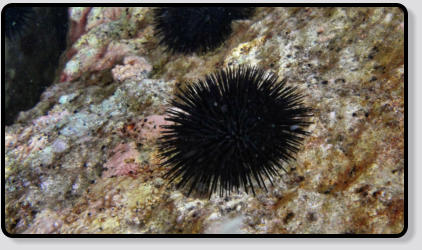
Description
The black sea urchin, Arbacia lixula is a species of sea urchin from Europe.
It is a medium-sized sea urchin, characterized by its deep black color and its haemispherical shape. All of its spines are roughly the same size
(no "secondary spines"), and worn erected (never dishevelled when in the water). The anus on the top is surrounded by four plates forming an
anal valve. The oral face is nearly naked, the mouth being surrounded by soft, dark-greenish skin.
This species can be confused with the purple sea urchin Paracentrotus lividus, but the latter is never really black (though often very dark), has
more dishevelled spines of many lengths, covers itself with debris, has spines around the mouth and no anal valve, and does not live exposed on
the cliffs.
This species can be found on the coast of the Mediterranean Sea and Macaronesian Islands (Azores, Madeira, Canary Islands), and less
commonly, on the Atlantic coast of Western Africa and the Brazilian coast. It is found typically at shallow waters, at depths from 0 to 30 m, in
rocky shores. It has a good resistance to hydrodynamism due to a good attachment strength to rocks.

Animalia
Scientific classification
Kingdom:
Phylum:
Echinodermata
Class:
Echinoidea
Order:
Spatangoida
Family:
Brissidae
Genus:
Brissus
Species:
B. Unicolor
Brissus Unicolor
Binomial name




White Heart Urcgin
Brissus Unicolor
Grauer Herzseeigel
Erizo Irregular
Grauwe Hart Zee-egel
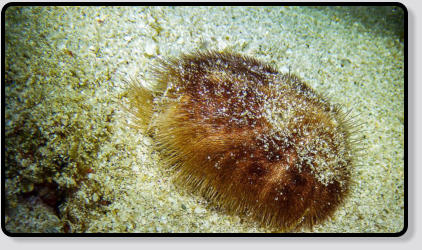
Description
Brissus unicolor is a species of sea urchins of the Family Brissidae. Their armour is covered with spines. Brissus unicolor was first scientifically
described in 1778 by Leske.
No further information available on Wikipedia.
Animalia
Scientific classification
Kingdom:
Phylum:
Echinodermata
Class:
Echinoidea
Order:
Diadematoida
Family:
Diadematidae
Genus:
Diadema
Species:
D. Antillarum
Binomial name (link Wikipedia)




Black Long-spined Sea Urchin
Oursin Diadème
Schwarzer Diademseeigel
Erizo Diadema
Puntige Zwarte Zee-egel
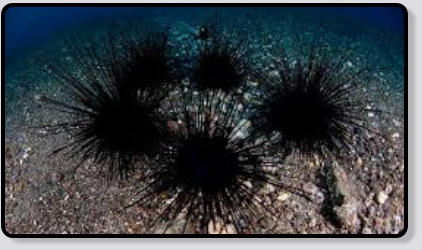
Description
Diadema antillarum, also known as the lime urchin, black sea urchin, Grabaskey's bane or the long-spined sea urchin, is a species of sea urchin
in the Family Diadematidae. This sea urchin is characterized by its exceptionally long black spines.
It is the most abundant and important herbivore on the coral reefs of the western Atlantic and Caribbean basin. When the population of these sea
urchins is at a healthy level, they are the main grazers which prevent algae overgrowth of the reef.
Diadema antillarum has a test, or "shell," similar to most other sea urchins. What distinguishes the Diadema is the length of its spines.
Most sea urchin spines are 1–3 cm, but the spines in this species are usually 10–12 cm in length, and can grow as long as 30 cm in very large
individuals.
This species usually lives at 1–10 metres in depth on coral reefs. They will often lodge themselves in a crevice, so that only their spines can be
seen, but individual urchins who can't find a suitable crevice will live in more exposed situations. Individuals that have been able to find a crevice
usually will roam about one metre from their crevice at night during feeding. Diadema is very sensitive to light, and will often pick its crevice or
resting place based on how much shade there is.
Diadema mostly eat algae, and sometimes seagrass. Starving urchins have been known to become carnivorous.
Animalia
Scientific classification
Kingdom:
Phylum:
Echinodermata
Class:
Echinoidea
Order:
Echinoida
Family:
Echinidae
Genus:
Paracentrotus
Species:
P. Lividus
Binomial name (link Wikipedia)




Sea Urchin
Oursin
Paracentrotus Lividus
Erizo de Mar Común
Rotszee-egel
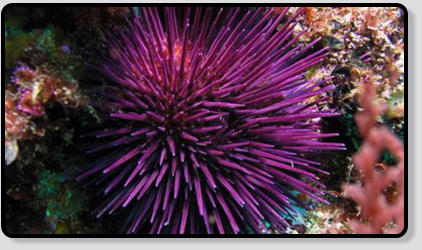
Paracentrotus lividus is a species of sea urchin in the family Parechinidae commonly known as the purple sea urchin. It is the type species of the
genus and occurs in the Mediterranean Sea and eastern Atlantic Ocean.
P. lividus has a circular, flattened greenish test with a diameter of up to seven centimetres. The test is densely clothed in long and sharply pointed
spines that are usually purple but are occasionally other colours including dark brown, light brown and olive green. There are five or six pairs of
pores on each ambulacral plate. The tube feet are in groups of 5 or 6, arranged in small arcs.
P. lividus is found throughout the Mediterranean Sea and in the eastern Atlantic Ocean from western Scotland and Ireland to the Azores, Canary
Islands and Morocco. It is most common in the western Mediterranean, the coasts of Portugal and the Bay of Biscay, where the water
temperature in winter varies between 10 and 15°C.
Description
Animalia
Scientific classification
Kingdom:
Phylum:
Echinodermata
Class:
Echinoidea
Order:
Temnopleuroida
Family:
Toxopneustidae
Genus:
Sphaerechinus
Species:
S. Granularis
Binomial name (link Wikipedia)




Purple Sea Urchin
Oursin
Violetter Seeigel
Erizo de Púas Cortas
Paarse Zee-egel.
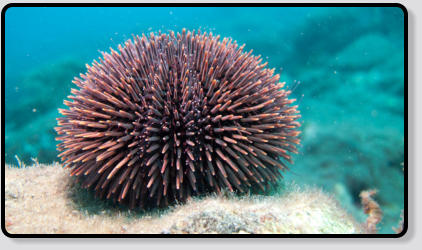
Sphaerechinus granularis is a species of sea urchin in the family Toxopneustidae, commonly known as the purple sea urchin. Its range includes
the Mediterranean Sea and eastern Atlantic Ocean.
S. granularis is a large sea urchin, somewhat flattened dorsally and growing to fifteen centimetres in diameter. There are two distinct colour
forms. The test is purple in both but one has purple spines and the other white. The spines are short and blunt, all the same length, and arranged
neatly in rows.
S. granularis is found in the Mediterranean Sea and the eastern Atlantic Ocean, from the Channel Islands south to Cape Verde and the Gulf of
Guinea. It favours sheltered locations and lives on rocks covered with seaweed or gravelly substrates. It is usually found in the neritic zone down
to about thirty metres but occasionally down to a hundred metres in more exposed locations. It is also found in meadows of the seagrass
Posidonia oceanica.
Description
Animalia




Harry van Goor 2016
source: Wikipedia, the free encyclopedia


Categories: Sea Urchin




